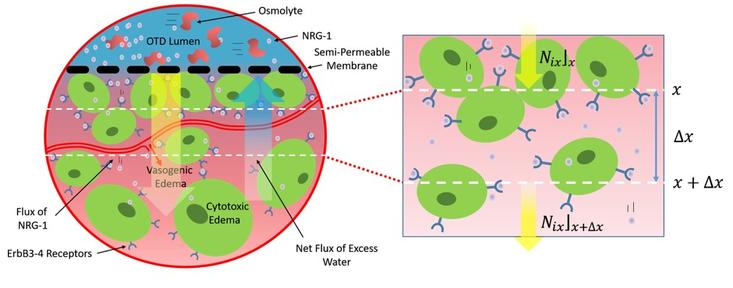Reduction of Edema and Delivery of Neuregulin-1 for Severe Stroke Patients
Overview
Cerebral edema is a fatal pathological state that involves an abnormal accumulation of fluid within the extracellular and intracellular space of the brain following traumatic brain injury and/or stroke. Currently, medical treatment of cerebral edema focuses on managing the buildup of fluid but does not stop the underlying causes of the swelling. With our collaboration with Dr. Byron D. Ford, Professor of Biomedical Sciences in the School of Medicine at the University of California, Riverside, we are developing a scalable osmotic transport device (OTD) to reduce the buildup of cerebral edema as well as delivering the neuroprotective growth factor neuregulin-1 (NRG-1) to the brain.
Our previous studies have demonstrated the OTD to reduce cerebral edema following severe TBI and resulted in improved neurological outcomes in the mouse model. The OTD consists of semipermeable hollow fiber membranes embedded in a hydrogel that is placed directly on the exposed site of injury after decompressive craniectomy. Within the hollow fibers, an aqueous fluid containing concentrated osmolytes cannot pass through the membrane. This causes an osmotically driven flux due to the resulting pressure gradient; fluid will be removed from the tissue into the hydrogel and hollow fibers to be removed from the patient. Osmotic pressure is induced at walls of the hollow fibers since the osmolyte is incapable of permeating across the semipermeable membrane.
Generally, only low molecular weight, lipid-soluble molecules, and a few peptides can cross the blood brain barrier by passive diffusion or using specific transport mechanisms. For most drugs, it is not possible to achieve therapeutic levels within the brain tissue following intravenous or oral administration especially in an injured case where the blood vessels have been compromised. To overcome these limitations, the OTD has the potential to deliver our compound of interest, NRG-1 - a growth factor contributing to the survival and function of neuronal cells, directly onto the brain tissue. Through his previous studies, Dr. Ford has investigated the neuroprotective roles of NRG-1 in stroke and other acute neuroinflammatory brain injury models. Following traumatic brain injury, NRG-1 is induced in neuronal cells and has been shown to reduce ischemia-induced neuronal death, inflammation, and promote neuronal repair in rodent stroke models.
Using this device, we plan on removing the buildup of cerebral edema as well as delivering NRG-1 to the brain.
Related Publications
1. McBride, D.W., et al., Reduction of cerebral edema after traumatic brain injury using an osmotic transport device. Journal of neurotrauma, 2014. 31(23): p. 1948-1954.
2. McBride D.W., et al., Improved survival following cerebral edema using a novel hollow fiber-hydrogel device. Journal of Neurosurgery, 2012. 116(6): p. 1389-1394.
3. McBride, D.W., et al., Reduction of Cerebral Edema via an Osmotic Transport Device Improves Functional Outcome after Traumatic Brain Injury in Mice, in Brain Edema XVI. 2016, Springer. p. 285-289.
4. Wang, S., et al., Spatio-temporal assessment of the neuroprotective effects of neuregulin-1 on ischemic stroke lesions using MRI. Journal of the neurological sciences, 2015. 357(1-2): p. 28-34.
5. Li, Y., et al., Neuroprotection by neuregulin-1 in a rat model of permanent focal cerebral ischemia. Brain Research, 2007. 1184: p. 277-283.
6. Xu, Z., et al., Neuregulin-1 is neuroprotective and attenuates inflammatory responses induced by ischemic stroke. Biochemical and Biophysical Research Communications, 2004. 322(2): p. 440-446.
